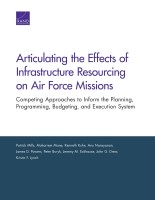| 来源类型 | Research Reports
|
| 规范类型 | 报告
|
| DOI | https://doi.org/10.7249/RR1578
|
| ISBN | 9780833096777
|
| 来源ID | RR-1578-AF
|
| Articulating the Effects of Infrastructure Resourcing on Air Force Missions: Competing Approaches to Inform the Planning, Programming, Budgeting, and Execution System |
| Patrick Mills; Muharrem Mane; Kenneth Kuhn; Anu Narayanan; James D. Powers; Peter Buryk; Jeremy M. Eckhause; John G. Drew; Kristin F. Lynch
|
| 发表日期 | 2017
|
| 出版年 | 2017
|
| 页码 | 98
|
| 语种 | 英语
|
| 结论 |
Analytic Approaches to Articulating the Effects of Funding Infrastructure Below Stated Requirements- A project scorecard approach is easy to understand and implement, but the mission impact of some projects may be uncertain, this approach may involve an overwhelming amount of information, and it tends to focus on the near term.
- A mission outcome metrics approach involves building logic and mathematical models to link and quantify the effects of infrastructure funding on mission outcomes. Such an approach can provide interesting insights and can express long-term impacts, but mission outcome models can be costly to develop, and not all missions may be amenable to this kind of analysis.
- The composite risk metrics approach entails gathering and synthesizing data about infrastructure performance (using metrics like condition and functionality), applying performance thresholds based on user needs, then translating those ratings to some kind of holistic risk framework. This approach takes advantage of the Air Force's current information systems and can express long-term impacts, but this is the most abstract of the three approaches, and it requires fully populating the Air Force's data systems.
- All three approaches may have a place in the Air Force as it transitions away from the status quo, though choosing a path ahead will require more thought and collaboration with infrastructure users and Air Force decisionmakers, and implementing that approach will likely require gathering more information.
- Infrastructure-to-mission mapping exercises appear to have several potential side benefits.
- Solid risk analysis and communication are necessary, but not sufficient, for successful advocacy for infrastructure funding in the Program Objective Memorandum (POM) process.
|
| 摘要 |
- Assess the POM environment more deeply to determine the best way to implement the project scorecard approach to capitalize on its ease of implementation but avoid its pitfalls.
- Continue to fully populate existing sustainment management systems, and embrace and implement new ones as they are launched, with an eye toward informing a composite risk metric approach.
- Make targeted assessments to determine when to use models to quantify mission outcome metrics.
- Undertake high-level institutional action to educate stakeholders about the effects of infrastructure underfunding.
|
| 主题 | Defense Infrastructure
; Maintenance
; Repair
; and Overhaul
; Military Budgets and Defense Spending
; Military Facilities
; United States Air Force
|
| URL | https://www.rand.org/pubs/research_reports/RR1578.html
|
| 来源智库 | RAND Corporation (United States)
|
| 引用统计 |
|
| 资源类型 | 智库出版物
|
| 条目标识符 | http://119.78.100.153/handle/2XGU8XDN/108505
|
推荐引用方式
GB/T 7714 |
Patrick Mills,Muharrem Mane,Kenneth Kuhn,et al. Articulating the Effects of Infrastructure Resourcing on Air Force Missions: Competing Approaches to Inform the Planning, Programming, Budgeting, and Execution System. 2017.
|
|
文件名:
|
x1495316778041.jpg
|
|
格式:
|
JPEG
|

|
文件名:
|
RAND_RR1578.pdf
|
|
格式:
|
Adobe PDF
|
除非特别说明,本系统中所有内容都受版权保护,并保留所有权利。